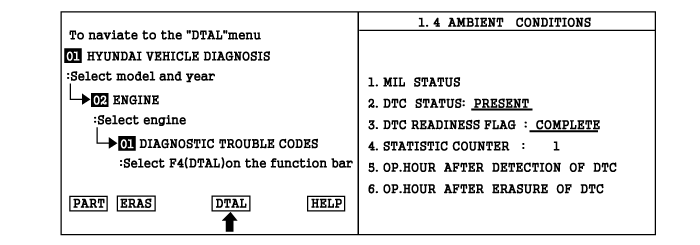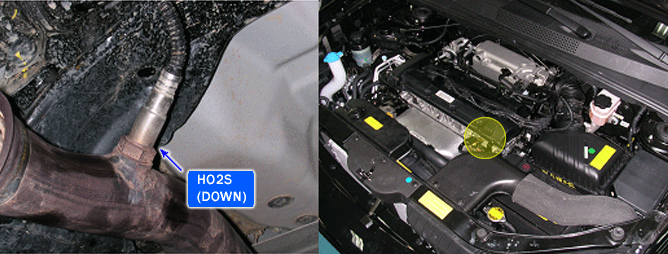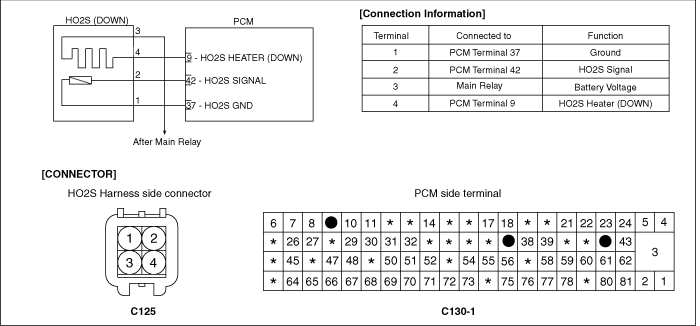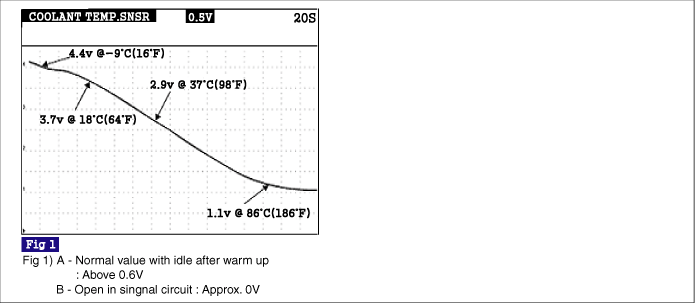Read "DTC Status" parameter.


The rear heated oxygen sensor is mounted on the rear side of the Catalytic Converter (warm-up catalytic converter) or in the rear exhaust pipe, which is able to detect catalyst efficiency. The rear heated oxygen sensor (HO2S) produces a voltage between 0V and 1V. This rear heated oxygen sensor is used to estimate the oxygen storage capability. If a catalyst has good conversion properties, the oxygen fluctuations are smoothed by the oxygen storage capacity of the catalyst. If the conversion provided by the catalyst is low due to aging, poisoning or misfiring, then the oxygen fluctuations are similar to signals from the front oxygen sensor.
Due to possible oxygen sensor defects (e.g. reference air poisoning) or faults in the injection system (e.g. leaking fuel injector), the rear oxygen sensor may not provide the expected lean or rich signal level during fuel cut-off or full load condition. Hence, the oxygen sensor signal is checked for plausibility during this engine operating states.
There are 2 cases which DTC P0140 sets.
(I) Signal monitoring during fuel cut-off: The PCM monitors rear O2 sensor signal level during fuel cut-off which normally shows near 0V and sets DTC P0140 when signal level is too high.
(II) Signal monitoring after fuel cut-off: The PCM monitors rear O2 sensor signal level for a certain time after leaving fuel cut-off and sets DTC P0140 when signal variation during checked period is too small.
ITEM | DETECING CONDITION | POSSIBLE CAUSE | |
Case1) | DTC Strategy | ● Signal plausibility during fuel cut off | ● Related fuse blown or missing ● Contact resistance in connectors ● HO2S contamination |
Enable Conditions | ● Sensor preheating and full heating phases finished ● In fuel cut off phase ● Integrated mass air flow > 20g ● No relevant failure ● 10V < Battery voltage <16V | ||
Threshold Value | ● Voltage with fuel cut off > 0.1V | ||
Diagnostic Time | ● 5 seconds | ||
Case2) | DTC Strategy | ● Signal plausibility after fuel cut off | |
Enable Conditions | ● Integrated engine load in fuel cut off > 12g ● Integrated engine load after fuel cut off > 40g ● Coolant temperature > 74°C(165°F) ● In Closed loop mode ● Catalyst temperature > 350°C(662°F) ● No relevant failure ● 11V < Battery voltage < 16V | ||
Threshold Value | ● Sensor signal increase < 10mV | ||
Diagnostic Time | ● 5 after fuel cut off phase | ||


If any misfire, Purge Solenoid Valve, Mass Air Flow Sensor or O2 Sensor heater codes are present, DO ALL REPAIRS associated with those codes before proceeding with this troubleshooting tree.
Connect scan tool and select "Diagnostic Trouble Codes(DTCs)" mode.
Press F4(DTAL) to select DTC information from the DTCs menu.
Confirm that "DTC Readiness Flag" indicates "Complete". If not, drive the vehicle within conditions noted in the freeze frame data or enable conditions.
Read "DTC Status" parameter.

Is parameter displayed "History(Not Present) fault"?
History (Not Present) fault : DTC occurred but has been cleared.
Present fault : DTC is occurring at present time.

▶ Fault is intermittent caused by poor contact in the sensor's and/or ECM's connector or was repaired and ECM memory was not cleared. Thoroughly check connectors for loose or poor connection, bending, corrosion, contamination, deterioration, or damage. Repair or replace as necessary and go to "Verification of Vehicle Repair" procedure.

▶ Go to next step as below.
Many malfunctions in the electrical system are caused by poor harness(es) and terminals. Faults can also be caused by interference from other electrical systems, and mechanical or chemical damage.
Thoroughly check connectors for looseness, poor connection, bending, corrosion, contamination, deterioration, or damage.
Has a problem been found?

▶ Repair as necessary and go to "Verification of Vehicle Repair" procedure.

▶ Go to "HO2S Fuse Inspection" procedure.
Ignition "OFF" & Engine "OFF".
Verify "10A Sensor fuse" is installed and not blown.
If OK, go to "Component Inspection" procedure.
If NG, replace fuse and repair any shorts as necessary and go to "Verification of Vehicle Repair" procedure.
Visually/physically inspect following items:
Ensure that the sensor is securely installed
Check for corrosion on terminals
Check for damaged wiring
Repair as necessary and go to next step
Warm up the engine to normal operating temperature and check that HO2S signal is active.
Connect Scantool and monitor the "O2 SNSR VOLT.(B1/S2)" parameter on the Scantool data list.
Test Condition : Ignition "ON" & Engine "ON" & In Idle("Closed Loop")condition
Specification : Above 0.6V

Is sensor data near the specified value?

▶ Check for poor connection between PCM and component: backed out terminal, improper mating, broken locks or poor terminal to wire connection. Repair as necessary and go to "Verification of Vehicle Repair" procedure.

▶ Check HO2S for contamination, deterioration, or damage. Substitute with a known-good HO2S and check for proper operation. If the problem is corrected, replace HO2S and then go to "Verification of Vehicle Repair" procedure.
After a repair, it is essential to verify that the fault has been corrected.
Connect scan tool and select "Diagnostic Trouble Codes(DTCs)" mode.
Press F4(DTAL) and confirm that "DTC Readiness Flag" indicates "Complete". If not, drive the vehicle within conditions noted in the freeze frame data or enable conditions.
Read "DTC Status" parameter.
Is parameter displayed "History(Not Present) fault"?

▶ System performing to specification at this time. Clear the DTC

▶ Go to the applicable troubleshooting procedure.